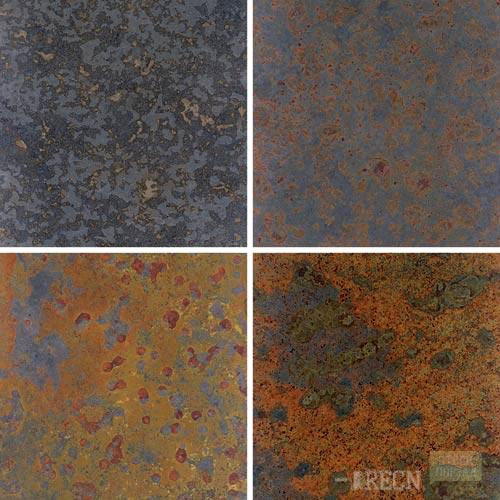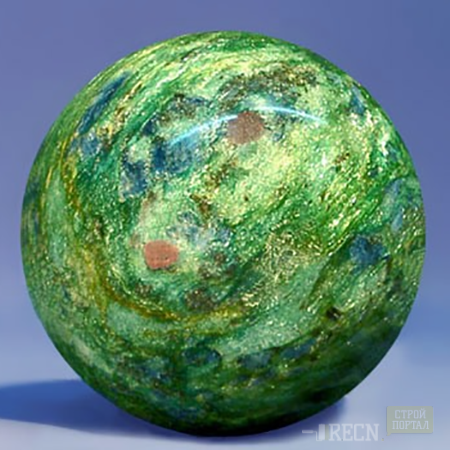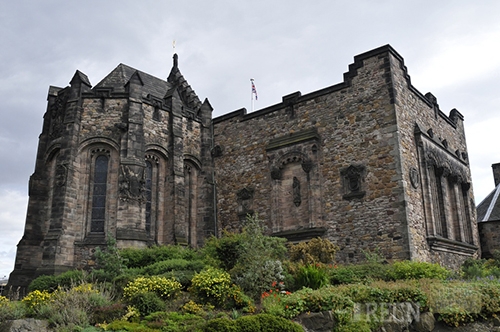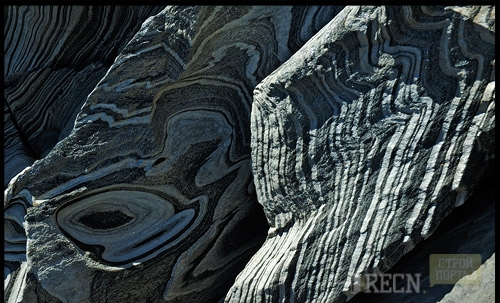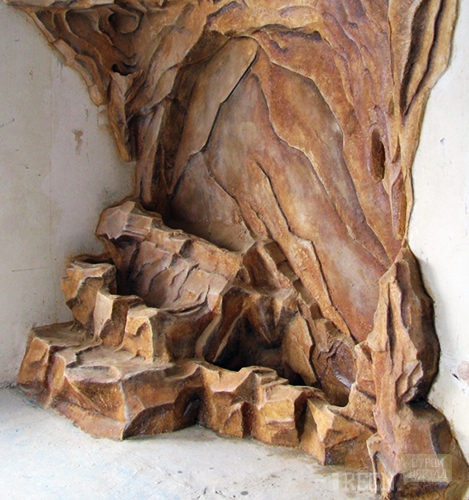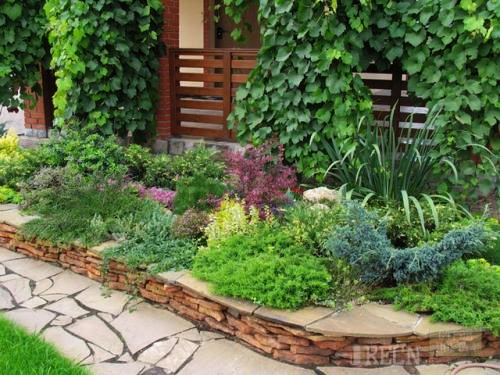
Application of slate in landscape design Building materials

Modern landscape design is the most real magic available to everyone. And the most important rules are decorative, harmony and naturalness. And even though naturalness is the last on this list, it is sometimes extremely difficult to achieve it. That is why slate loved the landscape designers. Incredibly beautiful natural material, which is not suitable for decorative design of gardens, facades and interiors.
Content
What is slate
Slate is an extremely popular material in landscape design, due to its environmental friendliness and versatility in use. They can be paved tracks, place a swimming pool or fountain, decorate the platform for barbecue, fences, alpine slides, etc. But most importantly, the slate serves as a reliable "bridge", harmoniously binding artificial materials and natural elements of the landscape.
Slate is not a stone rock, but rather, a group of minerals, which consists of several rocks with similar characteristics. The main feature of the shale is overlap, that is, the ability to be divided into records of different thickness.
Views
Since the concept of shale includes not one and not even five, but many rocks, there is a classification, dividing them into three main types:
- clay;
- crystalline;
- phillit.
If clay and crystalline slates differ in their composition (clay components are dominated in some - crystalline), then the phyllites are considered an intermediate phenomenon. These are chlorite and green rocks, as part of which in addition to mica contains a large number of color or green minerals such as chlorine, epidote and various amphiboles. Green shale are formed by sedimentary and volcanic rocks.
But all kinds of slate have one general quality - thanks to a durable and layered structure, a unique and extremely expressive surface texture is created, which conquered the world of landscape design. For this reason, even the ubiquitous application of a slate allows you to create unique works of landscaped art to the joy of country area owners. Moreover, even with a great desire, you are unlikely to create two completely identical images from the slate.
The selection of slate to decorate your site is similar to the collecting of brands - choosing a variety in this bright world, it is impossible to stay in one option and I want to take possession of the most beautiful and rare copies ... Slant species and items are very much. The Ural shale, for example, is distinguished by a fine-grained structure with completely lured structures and primary mountain texture. They are very dense, absorb the minimum amount of moisture, racks for weathering, and their high strength is caused by perpendicular layers of the rock. From a decorative point of view, the Ural shale is simply magnificent - rare even for shale rocks "Malachite" colors and inclusions of mica carry even the most sophisticated connoisseurs.
Specifications
The first shale, according to excavations, appeared about 400 million years ago, but then, of course, he was unlikely to use him as a decoration of garden sites. The era of dinosaurs had sunk in the summer, giving way to the era of the human resources era, but for the first time at the slate, as for the building material, only at the end of the 15th century drew attention. Almost immediately, the slate became very in demand in all spheres of construction. His durability, water-repellent properties and enviable durability could not be compared with any material of that time. It was used everywhere, ranging from the construction of houses and sheds, ending with the construction and decoration of majestic palaces. So, the slate is covered by the famous Louvre, almost all vintage temples, the Buckingham Palace, Edinburgh Castle in Scotland and many other works of architectural art of those times.
Practical Germans, as and 200 years ago, today we prefer a slate to all other roofing materials. The durable roof of natural color and with a unique texture shines brightly in the sun and creates the effect of just cleansing and washed stone. Such an effect of "purity" is very valued not only with aesthetic, but also from a practical point of view, since the slander's surface is simply not able to scap dust and dirt.
Since its discovery, the slate as a minute did not lose its popularity for a minute. But today there is a real "shale boom" among landscape designers. Moreover, the customers do not even scare away even a shamelessly high price of slate. It is understandable - such durability and beauty will pay off in any case, and even the right to enjoy the fruits of your work.
But excellent decorative properties and durability are not all the advantages of shale breeds.
So, there is a lot of performance and technical qualities of this material:
- high heat insulation;
- excellent sound insulation;
- plasticity (the slate is not cracking and easily treating, acquiring the desired form);
- maximum waterproof;
- fire resistance (with the exception of a fuel slate, which contains a large number of algae decomposition products or dispute);
- absolute environmental purity material;
- anti-corrosion (slate is not affected by bacteria, fungi, pests);
- resistance to harsh operational conditions, adverse conditions of the external environment, aggressive chemical impact.
Among other things, the slate is extremely easy. His weight is much smaller than the mass of popular cement-sand tile. The square meter of the slate weighs from 45 to 50 kg.
Application in landscape design
The beauty and originality of the slate paved him a wide road into the world of landscape design. As we have already mentioned above, shale are several types (clay, crystalline, phyllitis), and they all found the use in the arrangement and decoration of household plots.
Clay slates serve as a slate coating for houses, attacks, arbors and any other buildings. It is not as bright as other types of shale, so its "neutral" shades are perfectly suitable for roofing work.
Crystal slates, on the contrary, are distinguished by incredible brightness and attractiveness. That is why they found the use of decorative construction work. With the help of elements from the crystalline slate, the loft decorate and emphasize its natural splendor. Since this type of slate can be different colors, designers actively use it in operation.
No construction of landscape compositions do without shale. It is also suitable for creating retaining walls, terraces, elevated flower beds and mountaineering, for facing water bodies, grottoes, and even creating artificial rocks. This is the most natural and natural building materials in a landscape designer arsenal who has no worthy alternative to its qualities and characteristics.
Artificial rocks
The favorite composition of many landscape designers is an artificial rock on the plot. Such a nuance is able to decorate any garden, and a durable and reliable slate is used for its construction. Shale base withstands temperature drops, strong wind gusts, long-term humidity or drought - in general, is ideal for the role of the "real cliff".
Shale cliffs are much more durable of stone, and even talk about their beauty and is unnecessary. Thanks to the unique properties of shale rocks, the appearance of your artificial cliff will continue in a constant state for many years. Moreover, you will not have to cover the design from bad weather or hiding under polyethylene in winter - the slate will endure any tests.
However, the construction of an artificial cliff is better to entrust the professional landscape designer (however, like any other manipulations with a shale), since the slate is quite a "capricious" material when laying. Any mistake can affect the appearance and operational qualities of your creation. In addition, the slate is expensive, so it will be very disappointing "throw out money on the wind, without having received the desired result.
Raised flower bed
Raised flower beds are back into fashion today, and many home destroyers wish to acquire beautiful flower beds on natural hills. Such clubs are very compact and look rather neat and non-standard. In addition, raised flower beds are an excellent alternative to mountaineering, because to build and care for them is much easier and cheaper than the alpine slide.
To create highlighted clubs, use a slate glybnyak. The height of the composition may vary from 20 cm to 1.5 meters. If you have a lot of space, then the flower bed can be given the type of terrace with several levels. If the height of the clubs exceeds 30 cm, its base must be concrete.
You can put everything that the soul wishes in the raised flower. For flower beds with several levels, plants are suitable for the Alpine slide (more in the article " How to choose the right plants for the alpine slide»).




